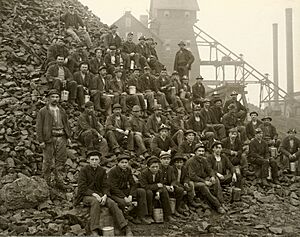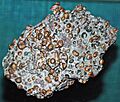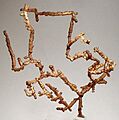Copper mining in Michigan facts for kids
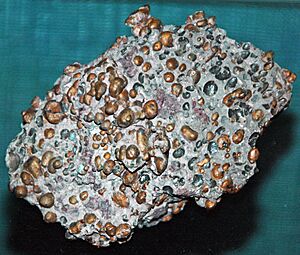
Copper mining in Michigan was a very important industry in the 1800s and early 1900s. It helped start copper mining as a major business in the United States. Michigan's copper was special because it was mostly found as pure copper metal, not mixed with other minerals.
Contents
Where is Michigan's Copper Found?
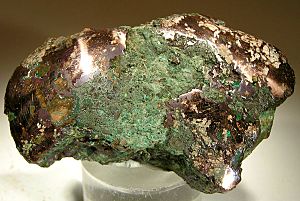
In Michigan, copper is almost only found in the western part of the Upper Peninsula. This area is known as the Copper Country. It's very unusual because the copper is mostly found as pure native copper metal. In most other places, copper is found in rocks mixed with other elements, like copper oxides or sulfides.
The copper deposits are in very old rocks, from a time called the Precambrian era. These rocks include thick layers of sandstone, conglomerates, and basalts. These layers formed because of a huge crack in the Earth's crust called the Midcontinent Rift.
The pure copper is found in cracks in the rocks called fissures. It's also found in the bubbly tops of ancient lava flows (called amygdaloids) and in layers of conglomerate rock. Early miners first dug for copper in these fissures. Later, they found more copper in the amygdaloid and conglomerate layers.
Sometimes, other copper minerals like chalcocite (a copper sulfide) were found. In some mines, copper arsenide minerals like mohawkite were also present. Many copper mines also had a lot of silver. Sometimes, pure copper and pure silver were found together in the same rock. This special rock is called halfbreed and is only found in Michigan.
Early Copper Miners: Native Americans
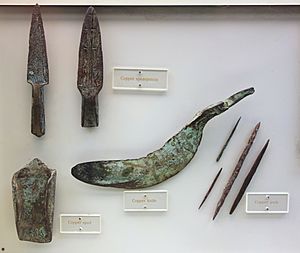
Native Americans were the first to mine and use copper from the Lake Superior area. This happened between 5000 BCE and 1200 BCE. They used this copper to make tools. Scientists have found old copper mining pits and hammering stones on the Keweenaw Peninsula and Isle Royale. These show how they worked the copper.
Some people think a huge amount of copper was taken out during this time. However, archaeologists say these numbers are not certain. They do agree that Native Americans used copper for a very long time. They continued to use it until Europeans arrived in the 1600s.
When the first European explorers came, the Chippewa people lived in the area. They did not mine copper themselves. The first written report about Michigan copper was in 1667 by a French missionary named Claude Allouez. He wrote that local Native Americans valued the copper nuggets they found. They even showed another missionary, Claude Dablon, a huge 1.5-ton piece of copper called the Ontonagon Boulder.
In the 1840s, American prospectors arrived. They found pieces of copper in streams and on the ground. A report by Douglass Houghton in 1841, along with a land treaty and the famous Ontonagon Boulder, started a big rush for copper. Many of the first successful mines were found in the old copper pits left by Native Americans.
Modern Copper Mining Begins
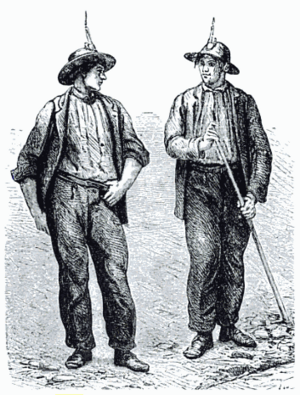
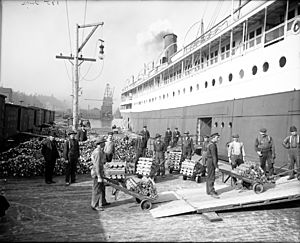
Douglass Houghton, who was Michigan's state geologist, wrote about the copper deposits in 1841. This report quickly led to many people coming to look for copper.
Mining happened along a strip about 100 miles long. This strip went through Ontonagon, Houghton, and Keweenaw counties. Copper mining in the Upper Peninsula grew very fast. From 1845 to 1887, Michigan was the top copper producer in the United States. For many years, Michigan produced more than three-quarters of the nation's copper. In 1869, it made over 95% of all the copper in the country!
Mining Fissure Veins
Commercial copper mining started in 1844 at the Phoenix mine. The first successful mine was the Cliff mine, which opened in 1845. Many others followed quickly. These early mines dug into copper-filled cracks in the rock, called fissure veins.
Miners sometimes found huge pieces of pure native copper. Some weighed hundreds of tons! It could take months to cut these giant pieces into smaller parts to bring them out of the mine. Even though the copper was pure, it was a lot of work and sometimes not even worth the effort. Most of the copper was "barrel copper" (pieces sorted by hand) or finer copper separated in special mills.
Mining Stratiform Deposits
In the 1850s, miners started digging in different types of deposits. These were layers of copper in conglomerate rocks and in the tops of lava flows (called amygdaloids). These deposits had lower amounts of copper than the fissure veins. However, they were much larger and easier to mine. Miners could blast the ore out, bring it to the surface, and send it to mills to separate the copper. This new way of mining was much more successful. The Quincy Mine was the first to successfully mine these layered deposits in 1856.
The most productive deposit was the Calumet conglomerate. It was opened by the Calumet and Hecla mining company in 1865. Most of the very successful mines were in the middle of the Copper Country. They were located along a strip about 2 miles wide and 24 miles long.
In the early 1900s, copper companies started to combine. Most mines in the Copper Country came under the control of two big companies: the Calumet and Hecla Mining Company and Copper Range Company.
Copper production reached its highest point in 1916. Most mines closed during the Great Depression because copper prices dropped. Many mines reopened during World War II when copper was needed for the war. After the war, prices fell again, and almost all companies closed. Only Calumet and Hecla, Quincy, and Copper Range remained. These companies mostly survived by reprocessing old mining waste to get copper that was left behind.
By 1968, the Calumet and Hecla company was bought by another company. Its mines were no longer producing much copper. The company tried to find more copper, but it wasn't successful. Later that year, the miners went on strike, and the new owners closed the mines for good. Only the Copper Range company's White Pine mine stayed open. This mine mostly dug for copper sulfides, not pure native copper. Michigan's native copper mining industry had mostly ended after producing billions of pounds of copper.
Several companies tried to reopen copper mines in the following years, but none lasted long or made a profit.
Impact of Copper Mining
For over 100 years, the copper industry was the most important thing in the Copper Country. Towns like Calumet, Houghton, Hancock, and Ontonagon grew because of the mines. When the mines closed, many people left the area, and some towns became like ghost towns.
Today, tourism, education, and logging are the main industries. The copper industry left behind many old mines and buildings. Some of these are now part of the Keweenaw National Historical Park. Some mines, like the Adventure mine and Quincy Mine, are open for tourists to visit.
Copper mining also changed the environment. Processing rocks left huge piles of sand called stamp sand. Some of these piles were so big they made it hard for boats to pass in the Keweenaw Waterway. Many of these areas are now being cleaned up. Mines also needed a lot of wood for tunnels and buildings. Almost all the trees in the Copper Country were cut down. Now, many of these areas have regrown, and some logging happens again.
White Pine Mine
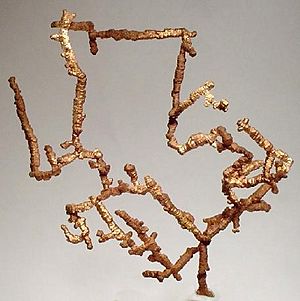
The copper in the Nonesuch Shale in Ontonagon County was known since the 1800s. But the copper here was mostly in sulfides and was hard to get out. This made it too expensive to mine.
In 1955, the Copper Range Company started large-scale mining at the White Pine mine. This mine was very successful. It produced over 1.8 million tons of copper during its operation. The White Pine mine was the last major copper mine in Michigan. It closed in 1995.
After it closed, the company wanted to try a new way to get copper. They planned to use acid to dissolve copper from the ground. However, there were problems with getting permits and protests from Native American groups. The company eventually stopped this project.
The area where the White Pine Mine stored its waste (tailings) has had environmental problems. Efforts have been made to restore the land. In 2021, news reports suggested that mining might return to White Pine.
Eagle Mine
The Eagle Mine is a different type of mine. It digs for nickel and copper sulfide deposits. It's located about 25 miles northwest of Marquette. Construction started in 2010, and mining began in 2014. The mine is expected to produce a lot of nickel and copper, along with other metals like platinum and palladium. The ore is processed at the Humboldt Mill and then shipped by train to other places.
Copperwood Mine
In 2013, a company called Orvana Corporation received permits to start mining copper north of Wakefield. They estimated that there was about one billion pounds of copper at their site, plus some silver. The project was later bought by Highland Copper Company. They are still working on plans and permits for the mine.
Images for kids
-
Cupriferous amygdaloidal basalt, "Shot copper." Wolverine Mine, Kearsarge, Michigan.
-
Mohawkite nugget, a mixture of domeykite, algodonite and native copper
-
Native copper nugget from glacial drift, Ontonagon County, Michigan. An example of the raw ore worked by Native Americans of the Old Copper Complex, 4000 to 1000 BCE.
-
Copper knife, spearpoints, awls, and spade made from copper deposits mined by Native Americans in Wisconsin from the Late Archaic period, 3000 BC-1000 BC.
-
Mid-19th century Cornish miners worked in the mines of the "Copper Belt" of the Keweenaw Peninsula of the Upper Peninsula of Michigan
-
Copper being loaded onto a steamer in Houghton, Michigan, c1905
-
Spectacular specimen of elongated, spinel-twinned copper crystals from the old White Pine mine.



